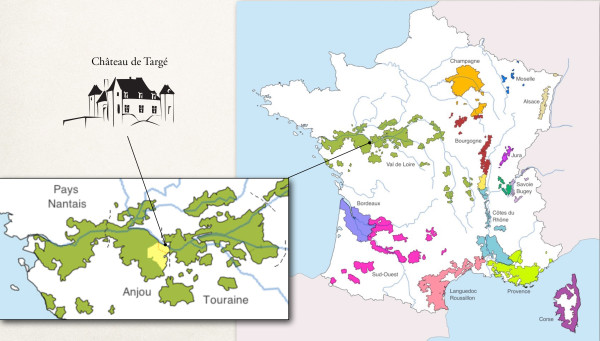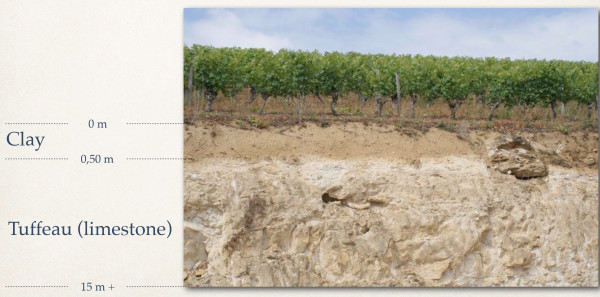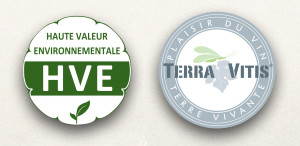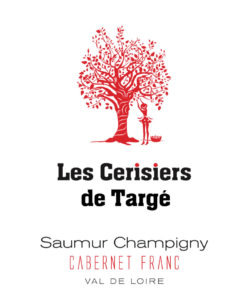
History
In 1655, Phelippeaux de Ponchartrain, the personal secretary to King Louis XIV of France, acquired a hunting lodge near the forests of the Royal Abbey of Fontevraud, along with the hilltop next to it. Since then, the property has been kept in the family, and each generation contributed to its construction and reputation. Henri Allain-Targé brought French politicians of the 3rd Republic like Gambetta and Villemain to the Chateau. Then, with the marriage of Geneviève Allain-Targé to Charles Ferry, brother of Jules Ferry (well known in France for his efforts in making school mandatory and free for all French youth), the Chateau became the privileged residence of the Ferry’s. Fresnette – their only descendant – and her husband Edgard Pisani, then Minister under de Gaulle, together restored the Château after all the damage done by the two World Wars.
Their son, Edouard Pisani-Ferry, agricultural engineer in winemaking, inherited the Château in 1976. He started by building a modern winery with thermo-regulated tanks, and then in the 1990’s expanded the vineyard by buying and exchanging terroirs in order to have the quality of land he thought the Château deserved. During this time, he also started to utilize environment-friendly methods for cultivation and vinification. Since 2000, he has been a member of the Terra Vitis association, which is committed to sustainable agriculture. Today, the estate covers an area of about 24 hectares (60 acres).

Location
The vineyard is grouped together on the coteau above the Château on the border of AOC Saumur-Champigny, and is located on the best soils of Parnay towards the Loire. The names of the parcels give a clue as to the maturity of the area: Clos Saint-Père, Clos du Moulin, Clos Saillant, Clos Vert…

Location Map
Climate
The name Saumur Champigny, after Latin “Campus Ignis,” means “Fire Field.” Indeed, the climate of the region is half oceanic, therefore quite mild and of steady temperature, but there is a microclimate over Saumur and Chinon, warmer and drier than the rest of the Loire Valley, with only 525 mm of yearly rainfall (national average being 900 mm). It enables the estate to produce exceptional red wines, which need more sun than white wine. This microclimate is explained by the hills that protect the region from most of the large clouds coming from the ocean, located 150 km southwest.
Soil
The soil is composed of clay and limestone (from superior cretaceous), while the subsoil results from sediment which settled 80-90 million years ago, allowing the formation of a hard chalk, white or light ochre: freestone. This composition, similar to a sponge, enables the rain to moisturize the subsoil without drowing it in water.
Fun Fact: The limestone from this terroir was used for the construction of hundreds of Chateaux along the Loire towards Nantes, as well as in England. The removal of the stone created caves which were ideal for the conservation of wine because of the fresh air and perfectly constant temperature.

The soils from upper Turonian (Jurassic)
Grape Varieties
All of the grapes planted are noble varietals of the Loire Valley: The Cabernet Franc (85%) from Saumur-Champigny, which is known for its ideal development on clay and limestone soils with a northern climate, as well as its delicate and elegant wines; the Chenin Blanc (15%) from the Saumur Blanc and Coteaux de Saumur: very typical of the region, its big personality wonderfully represents the soils of the vineyard. These two varietals are planted at a density of at least 5,000 vines per hectare.
Sustainable Development
The domain has been invested in sustainable development for more than a decade now, and has been awarded each year since 2000 when it joined the Terra Vitis label. Progressively since 2009, all of the vines have been cultivated without weed killer, insecticide, or chemical fertilizer. In 2017, the domaine began conversion to organic farming, with 2020 being the first certified organic vintage.


Saumur-Champigny Cabernet Franc
Appellation: AOC Saumur-Champigny
Soil: Clay-limestone from upper Turonian ( Jurassic): the microclimate around Saumur is the hottest and driest spot in the entire Loire Valley.
Grape Varieties: 100% Cabernet Franc
Yield: 50-60 hl/ha
Vineyard Management: Grassed-through, ploughed vineyards: no use of fertilizers, just compost. The aim is to produce naturally healthy grapes (thinning out the grapes and leaves for aeration, etc.), adhering strictly to the rules of sustainable agriculture.
Age of Vines: 10-40 years old
Harvest: Mechanical, in October, at a medium yield of 45 hl/ha in order to ensure concentration of flavors in the grapes
Vinification: In thermo-regulated stainless steel vats following a thorough double sorting on receipt. Use of maceration, aeration, and temperature control in the search for harmony, fruit, elegance, and depth.
Maturation: In thermo-regulated stainless steel vats, 9 months of maturation before bottling.
Tasting Notes: A ruby red Cabernet Franc, rich and fruit filled on the nose, backed up with soft tannins. Much appreciated in restaurants as it goes equally well lightly spiced fish or meat.
Cellaring Potential: 3-10 years
Serving Suggestions: Serve at around 17°C (60°F) with fresh peppered goat cheese, roasted pork, duck maigret, beef fondue, or even fish to accompany the lightest vintages (2007, 2012, 2013)

Saumur-Champigny Cabernet Franc Cuvée Ferry
Appellation: AOC Saumur- Champigny
Production Area: 3 ha
Soil: Clay-limestone from upper Turonian (Jurassic). The microclimate around Saumur is the hottest and driest spot in the entire Loire Valley.
Grape Varieties: Cabernet Franc
Yields: 35 / 40 hi per ha
Viticulture: Grassed-through and cultivated soils; no fertilizer, just compost. The aim is to produce naturally healthy bunches of grapes (thinning out of the grapes and leaves for aeration), adhering strictly to the rules of sustainable agriculture.
Vinification: In thermoregulated stainless steel vats following a thorough double sorting on reception. Use of maceration, pigeage (a device with railings pushes the skins into the juice) aeration and temperature control in the search for harmony and fruit, strength and depth.
Maturation: In thermoregulated stainless steel vats and partly in the oak barrels which have been used for the Quintessence. Bottled before end of the following year.
Tasting Notes: This cuvée is made from Cabernet Franc old vines and is partly oaked. The wine has a beautiful garnet color, a nose of dark fruits, and a clean and structured attack on the palate.
Cellaring Potential: Best to wait at least two or three years, for the next ten years or more.
Serving Suggestions: To enjoy at around 60°F with a special meal (T-bone sirloin, duck maigret…)

Saumur Chenin Blanc Les Fresnettes
Appellation: AOC Saumur Blanc
Production Area: 3 ha
Soil Type: Clay-limestone from upper Turonian (Jurassic). The microclimate around Saumur is the hottest and dryest spot in the entire Loire Valley.
Grape Varieties: 100% Chenin Blanc
Average Yield: 30-35 hl/ha
Viticulture: Grassed-through and cultivated soils; no fertilizer, just compost. The aim is to produce naturally healthy bunches of grapes (thinning out the grapes and leaves for aeration), adhering strictly to the rules of sustainable agriculture.
Harvest: Hand picking with 2 or even 3 selections. The grapes are very ripe, but the focus is to make a dry white.
Vinification: Direct filling in a pneumatic press, and once the must is settled, the fermentation takes place in 400 liters oak barrows (a third new, a third of one wine and a third of two wines).
Aging: The fermentations last weeks in barrel; as a whole the wine stays in them for 10 months, with partial or total malolactic fermentation. The stirring of the lees are made according to the vintage, so as to give body to the wine.
Cellaring Potential: The Chenin Blanc is well known for its longevity; 10 years or much more. Many do not wait to appreciate the fantastic aromas of fresh white fruits.
Tasting Notes: This delicious, dry Chenin Blanc was selectively harvested by hand from reduced yield vines, then fermented and and matured entirely in oak barrels resulting in a very classy, rich wine, with attractive hints of peach in the nose.

Saumur-Champigny Cabernet Franc Quintessence
Appellation: AOC Saumur-Champigny
Production Area: 1.50 ha
Soil: Clay-limestone from upper Turonian (Jurassic); the microclimate around Saumur is the hottest and dryest spot in the entire Loire Valley.
Grape Varieties: Old vines of Cabernet Franc (over 40 years old)
Yield: 25/30 hl per ha
Viticulture: Grassed-through and cultivated soils; no fertilizer, just compost. The aim is to produce naturally healthy bunches of grapes (thinning out the grapes and leaves for aeration), adhering strictly to the rules of sustainable agriculture.
Vinification: Small thermo-regulated stainless steel 50 hl vats are used as they provide perfect temperature control and proportion of skin to juice. Before the end of fermentation, racking is done directly into new oak 400 liter barrels.
Aging: The fermentations (alcoholic then malolactic) end entirely in the barrels. Aging lasts about 12-15 months, followed by blending and then the wine is bottled the following spring.
Cellaring Potential: 15 years or more
Tasting Notes: This special reserve is produced from old vines planted on a remarkable clay-limestone subsoil. The grapes are harvested just before becoming overripe. The fine and sugary tanins of the new oak barrels contribute to make the wine rich and subtle.

Saumur-Champigny Cabernet Franc Les Cerisiers de Targé
Appellation: AOC Saumur-Champigny
Grape Varieties: 100% Cabernet Franc
Yield: 50 hl/ha
Soil: Clay soil on Tuffeau subsoil. This rock is a sedimentary limestone formation from the Turonian age, 90 million years ago. The roots grow down in the top 70 to 90 cm of clay (25-35 inches), feeding the young vines, then get around the Tuffeau to find water and new nutrients that are naturally brought up through the rock by capillarity.
Climate: The meso-climate of the Saumur region is the hottest and driest in the entire Loire Valley.
Vinification: The grapes are put in stainless steel tanks with thermoregulation to start with a cold maceration, then a controlled temperature fermentation. Aerations of the wine and temperature are modulated depending on the vintage, with the aim of producing a harmonious, fruity, and elegant wine while keeping texture and volume on the palate.
Aging: In stainless steel tanks, for a bottling in June.
Alcohol: 13-13.5%, depending on the vintage
Cellaring: Gets to its optimum between 1 and 4 years and will develop beautifully up to 6-8 years.
Serving Temperature: Around 15°C (59°F)
Food Pairing: Pairs well with light but flavorsome dishes, such as steak with shallots, turkey and orange, skate with capers, and monkfish in mustard sauce. Perfect also with fresh peppered goat cheese — St. Maure de Touraine being the winemaker’s favorite.
Tasting Notes: Fruit-filled Cabernet Franc, lightly spiced on the nose and backed-up with soft tannins and ripe redcurrant and blackberry aromas in the mouth. Much appreciated in restaurants, as it complements equally spiced fishes, meat, and light dishes.

Chinon De Targé Cabernet Franc
Overview: After a massive attack of mildew in 2018 which ravaged the vineyard, then still in the midst of the transition to organic agriculture, the estate purchased grapes from Chinon from an excellent terroir. This is a very typical Chinon in a sumptuous vintage.
Grape Variety: 100% Cabernet Franc
Average Yield: 45 hl/ha
Soil: Heavy clays and quartz sands on the surface on a limestone bed at a depth of 1.2 meters.
Climate: This well-draining plot is located on the north face of the Chinon hill, which allowed it to keep a lot of freshness despite the great heat of the 2018 vintage.
Viticulture: Worked and grassed soils, in the middle of bocage hedges and biodiversity zones recreated every year since 2005. Strict controls have been imposed for the Terra Vitis labels since 2000, High Environmental Value since 2014, and organic agriculture since 2017.
Vinification: For this unique vintage, the harvest was done by hand and the winemakers used the same methods as for the Cuvee Ferry; the grapes are places in thermo-regulated steel vats for a cold maceration, followed by a temperature-controlled fermentation. Very little pumping over in order to limit the extraction which was done by itself, several airings and rather low temperatures in order to seek the complexity, structure and power of these grapes.
Aging: Aging is done in steel vats and the wine is bottles at the end of the following year.
Serving Temperature: 17°C
Food Pairings: This cuvee will adapt perfectly to slightly or strongly spiced cuisines, to grilled food accompanied by sauteed vegetables, or to winter dishes simmered for long hours.

Chenin De Targé Saumur Blanc
Appellation: AOC Saumur Blanc
Location: The vineyard is situated on a small mound located 2 to 3 meters above the rest of the plateau, which protects the vines from frost and ensures good exposure to the winds.
Soil: Silty and flinty clays 80 cm deep, then Turonian limestone in the subsoil.
Grape Varieties: 100% Chenin
Average Yield: 50 hl/ha
Viticulture: Strict controls have been imposed for the Terra Vitis labels since 2000, High Environmental Value since 2014, and Organic Agriculture since 2017.
Harvest: Manual harvest quite early to obtain freshness and lightness in the grapes.
Vinification: Direct pneumatic pressing of the grapes then settling in vats. Fermentation takes place in barrels for 4 weeks, then we rack off to make room for the Fresnettes in the barrels. Bottling takes place in the spring to lock in the fresh citrus flavors in the bottle, and 6 months later it is available for sale.
Food Pairings: Drink with seafood, oysters, fresh cheeses or quite simply as an aperitif, on the beach or on the terrace.
Cellaring: Consume within two years to preserve the aromas, salinity, and freshness.
Serving Temperature: 5°C, chilled is best!

Saumur Brut Rosé Méthode Ancestrale
Overview: The subsoil, 90 million years old, was made at the same time (Upper Cretaceous) as that of Vouvray and Champagne. This Crémant-style Brut is pure Cabernet Franc that highlights all the freshness and fruity aromas typical of the grape variety, for a festive wine very popular at weddings and other celebrations.
Soil: Clay over tuffeau (Turonian limestone that was formed over 90 million years ago). The roots grow a depth of 90 cm into the clay, nourishing the young plants, after which they circle around the tuffeau to find other nutrients and water, which are brought by root capillarity through the rock.
Climate: The Saumur mesoclimate is the hottest and driest in the entire Loire Valley.
Production Area: 0.5 ha
Grape Variety: 100% Cabernet Franc
Annual Production: 3,000 bottles
Yield: 50 hl/ha
Viticulture: Soils are ploughed and grassed; aeration by thinning and leaf stripping; natural compost is used. Strict controls have been imposed for the Sustainable Agriculture Terra Vitis labels since 2000, HVE – High Environmental Value since 2014, and Organic Agriculture since 2017.
Vinification: Manual harvest into openwork boxes; only perfectly ripened grapes are selected to give the wine a fresh and fruity character. Direct pneumatic pressing, slow and gentle so as not to extract bitterness. Fermentation is done in vats.
Aging: The tirage is done early in winter, then the bottles are allowed to rest on slats for a minimum of one year.
Alcohol: 12.5%
Dosage: 3-5 g/l
Cellaring: To be consumed within 2 years.
Serving Suggestion: Serve chilled as an aperitif, or as an accompaniment to dinner. It is a wine that we also like to drink without accompaniment to taste the fruit in all its simplicity.


